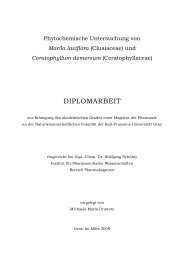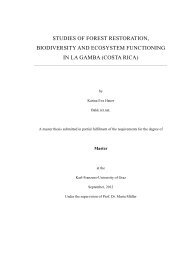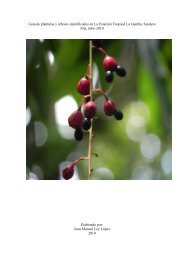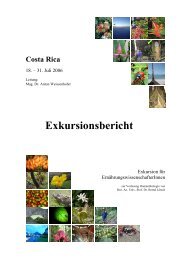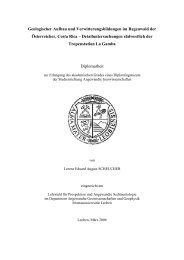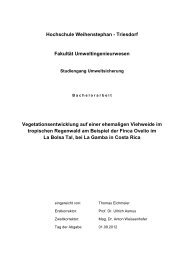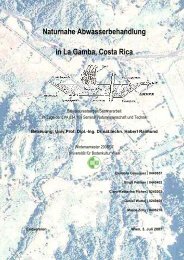Leaf colour patterns, vegetative and sexual reproduction of Episcia ...
Leaf colour patterns, vegetative and sexual reproduction of Episcia ...
Leaf colour patterns, vegetative and sexual reproduction of Episcia ...
Create successful ePaper yourself
Turn your PDF publications into a flip-book with our unique Google optimized e-Paper software.
flower. At the base <strong>of</strong> the corolla tube a spur is present on the dorsal side. It serves for collecting<br />
the secreted nectar.<br />
The corolla has a pale lilac to pale blue <strong>colour</strong>. Sometimes it appears almost white. At the<br />
entrance to the corolla tube a yellow blotch is present, which extends a few millimeter into the<br />
tube. Sometimes the yellow spot is dotted with red. The outside <strong>of</strong> the tube is pilose.<br />
The <strong>and</strong>roecium is composed <strong>of</strong> 4 stamens, which are divided into a filament <strong>and</strong> a dithecal<br />
anther with four pollen sacs. Dehiscence is by longitudinal slits. The stamens are inserted at the<br />
base <strong>of</strong> the corolla tube. The filament bases are broad <strong>and</strong> adjacent to each other. They form a<br />
sheath around the ovary. The four anthers are postgenitally united (Endress 1994). Two are fused<br />
laterally <strong>and</strong> all four are united apically (Fig. 24). During the male phase the anthers are placed at<br />
the entrance <strong>of</strong> the flower. This position is achieved by curving <strong>of</strong> the filaments.<br />
Figure 24 <strong>Episcia</strong> lilacina; left: <strong>and</strong>roecium, four anthers united postgenitally; right: closer view at two anthers,<br />
dehiscence is by longitudinal slits.<br />
The singular nectar gl<strong>and</strong> lies dorsally towards the spur at the base <strong>of</strong> the ovary.<br />
The ovoid ovary is superior, syncarpous <strong>and</strong> hirsute. The placentation is parietal with two<br />
placentae. The ovules arise from the inner <strong>and</strong> outer surfaces <strong>of</strong> the placentae. During the male<br />
stage (pollen release) the style has not reached its full length <strong>and</strong> the stigma is not receptive. At<br />
the end <strong>of</strong> the male stage, the filaments coil <strong>and</strong> the anthers are drawn back from the corolla<br />
entrance. The style starts growing in length so that the stigma reaches the same position the<br />
anthers occupied before. The stigma is divided into two lateral lobes. The lobes’ surface is<br />
covered with an area <strong>of</strong> papillae.<br />
The flower smells slightly <strong>of</strong> cucumber.<br />
50



